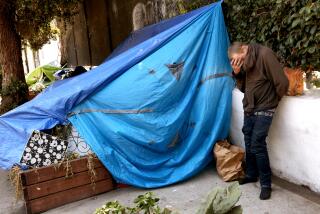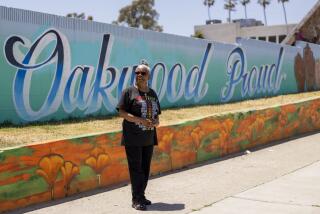Proponents are out to prove that some of the homeless are not looking for a free ride. : ‘Next Step’ Grooms Jobless for Mainstream
Randy Sessions sat in a Venice hair salon getting his first haircut in four months. Recently hired to work for an answering service and living in a halfway house, Sessions pronounced: “Things are looking up.”
Sessions, 22, is part of a small group of homeless people who are being helped by a combination of government and private programs based in Venice that aim to get unemployed transients back on their feet with jobs, bank accounts, permanent housing and even haircuts.
The strategy is to gradually return select homeless people to a more normal way of life--alleviating, however slightly, the homeless crunch in the Venice area.
Proponents of the effort say it helps homeless people help themselves as an alternative to programs that offer temporary shelter but little in the way of permanent recovery.
“This isn’t a mission setting,” said Steve Foster, a former drifter who is now supervisor in one of three transitional houses set up for the group. “It puts you back in a more normal life. It’s mainstreaming.”
He and other proponents said the effort allows homeless people to “stabilize” and teaches a certain amount of responsibility.
About 15 people are living in the transitional houses, which were provided by a coalition of Venice business and community leaders. The houses are in the Venice area but the addresses are not publicized to avoid attracting more homeless than could be handled, said Rick Ruiz, an aide to City Councilwoman Ruth Galanter.
The first step is providing jobs through a program set up by the City of Los Angeles, which is administered out of a trailer at the Venice Pavilion and staffed, in part, by former homeless people contracted by the city.
After a thorough screening, those deemed the most motivated are chosen to live in the halfway houses. Rules there are strict, according to the coordinators of the project: no drugs, no alcohol, a 10 p.m. curfew and mandatory sharing in household chores.
Bank accounts are opened for participants, who are required to regularly put aside a sizable percentage of their paychecks.
Once a certain amount of money is saved, the coalition offers to lend the person first- and last-month’s rents for permanent housing.
The support by business and community leaders, who belong to the Venice Action Committee and Venice Town Council, is part of a private project called Next Step. In addition to providing the halfway homes and move-in loans, they are collecting clothes to donate to the homeless who are participating.
Their efforts come at a time when Venice is being torn apart by opposing views on how to handle the growing number of homeless.
Next Step sponsors acknowledge that their effort is “embryonic,” with only a few people benefiting so far. They hope to raise $25,000 for rent deposits, and currently have about $7,500.
“We want to prove first that the pilot works,” said Michael Dieden, a Venice Action Committee officer and public relations consultant. “Once you prove that, more people will help. People don’t want a hand-out program.”
He said he hoped to attract the support of sympathetic landlords who would be willing to offer affordable housing to rehabilitated homeless people.
Miguel Capano, a former transient who was contracted by the city to help with job counseling and referrals as part of the jobs program, welcomed support from Next Step.
“We assumed everyone would be hostile,” Capano said.
Residents “were fearful at first, but then saw this (effort) was different. Now they understand we are not just taking people off the beach, unshaven, and forcing them onto” an employer, he said.
The homeless and the employer “have to be willing,” Capano said.
The right attitude is the key, according to the participants.
“A person has to take a bit of the initiative,” said Tony, 36, a newly arrived resident at one of the halfway houses who asked that his last name not be used.
“You can’t come with the attitude of (being) happy on the street panhandling. You have to be willing to work, to follow the rules. If you come in with a bad attitude, you’re not going to last.”
Tony said he had been laid off from his job in his New Jersey hometown, and then ran into bad luck in Los Angeles. After living several months on the beach, he hooked up with the jobs program.
Seated in the sparsely furnished halfway house, with mattresses on the floor around a big television set, Tony said the jobs program and privately sponsored support offered him “just the help I needed to get started again.”
Sessions, living in another of the transitional houses since December, was one of the first people in the project to receive a haircut, donated by Assemblyman Tom Hayden (D-Santa Monica). Susan Putnam, who said she had been cutting Hayden’s hair for years, said the assemblyman asked her to provide a haircut a week for program participants.
Sessions said the programs had helped restore his self-esteem, confidence and dreams of making a better life for himself.
“You have to want to do something with your life,” he said of those who can benefit from the programs. “It’s all based on wanting to do something for yourself. If you do, it’s a helluva program.
“Most people think the homeless are out for a free ride. There are those like that. But a lot just want to get a job.”
More to Read
Sign up for Essential California
The most important California stories and recommendations in your inbox every morning.
You may occasionally receive promotional content from the Los Angeles Times.











